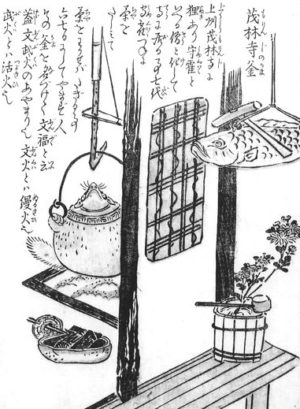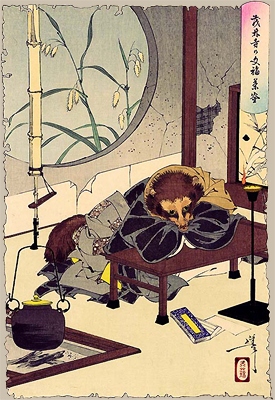One thing that I enjoy showing on my blog is not just different types of yokai, but specific examples of those types. For example, we’ve looked at oni in general, but also at Shuten Doji, Ibaraki Doji, Gozu, Mezu, and so on. We’ve also looked at kitsune in general, but then more closely at Tamamo no Mae. We have a general layout of kijo and hannya, but we also have the specific examples of Kurozuka, Kiyo hime, Rokujo ni and Miyasundokoro. We’ve looked at tatarigami, then of course at Taira no Masakado, Sutoku Tenno, Sugawara no Michizane, and others. And of course yurei and onryo, and you get the point…
Today is another specific example, this time of a tanuki!
Shukaku
守鶴
しゅかく

Toriyama Sekien’s “Morinji no kama”
This story is a well known one which comes from Tatebayashi City in Gunma Prefecture. There is a temple there called Morinji (technically Morin Temple, but usually—and redundantly—called Morinji Temple) which is the origin of the famous Edo period stories Bunbuku chagama, and Morinji no kama.
Morinji was founded in 1426 by a priest named Dairin Shōtsū. While he was traveling through various countries on pilgrimage, he befriended a priest named Shukaku, and they traveled together. After Morinji was built, Shukaku stayed on to act as a head priest there.
In 1570, an important gathering of priests was held at Morinji. Many priests from all over traveled and stayed at Morinji, and so of course a great number of tea kettles were needed to serve such a large crowd. Shukaku (yes, he was apparently still alive and kicking 144 years after his arrival) brought his favorite tea kettle to help serve the priests.

Tsukioka Yoshitoshi’s version
This tea kettle was a miraculous object, for no matter how many times you dunked a ladle in it, it was always brimming with enough hot water to make tea. It also stayed hot for many days after heating it! The kettle was given the name “bunbuku chagama;” chagama being the word for tea kettle, and bunbuku meaning “to spread luck.” The name was a bit of a pun as well—the sound of boiling water is bukubuku, which sounds very much like bunbuku.
Thanks to Shukaku’s marvelous tea kettle, the event was a great success, and the bunbuku chagama went on to be used to great success for many years. Shukaku, as well, continued to work at Morinji for many years after that. However, one day, in 1587 (February 28, 1587, according to Morinji’s records), while Shukaku was taking a nap, a monk walked in on him. He noticed that Shukaku had a tanuki’s tail! Thus, Shukaku’s great secret was uncovered: he was not a human, but a tanuki. A tanuki who had lived for many thousands of years, in fact. He had traveled through India, and through China, and then eventually he met Dairin Shōtsū, who brought him there to Morinji, where he used his magic to serve the temple as best as he could.

The Bunbuku Chagama
His secret uncovered, Shukaku decided it was time to leave Morinji. To make up for the great trouble he had caused, he gave them a parting gift: he used his magic to present the story of the Battle of Yashima, one of the final clashes of the Genpei War. To show their gratitude for Shukaku, the priests of Morinji enshrined him there as a local deity.
There are a couple of variations of this story floating about, and of course the concept of transformed animals hanging about with humans and doing favors for them is a common one in Japanese folklore. This one in particular has an added bit of interest, being so closely tied to a specific temple that is still around today. The bunbuku chagama is even on display at Morinji’s shrine to Shukaku. Visitors can look at it, but no word if you can heat it up and make infinite tea with it though.
Click on the cute little tanuki to go to the Kickstarter page for The Book of the Hakutaku, where you’ll find a bunch more yokai just like this one!


I’d guess Shukaku’s endless tea kettle was a bit of tanuki magic, so it probably wouldn’t work after he was gone. This has always been one of my favorite stories. I have a copy of Tsukioka Yoshitoshi’s print on my wall.
There are some versions of this story where the pot is the tanuki and not the monk! So it does vary a bit. 🙂
Yes! I like Studio Ghibli’s Pom Poko, where the tanuki (tanukis?) learn how to morph into objects, including teapots! LOL!
Yep! You can bet that was a direct reference to this!
ピンバック: A-Yokai-A-Day: Kidomaru | MatthewMeyer.net